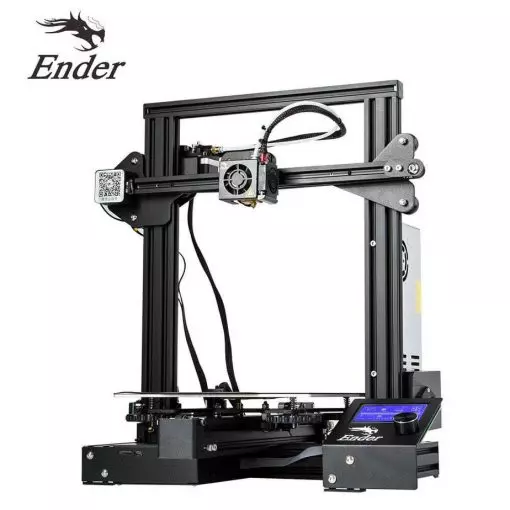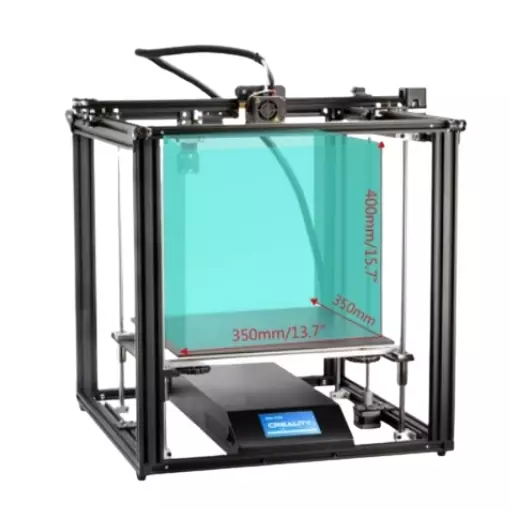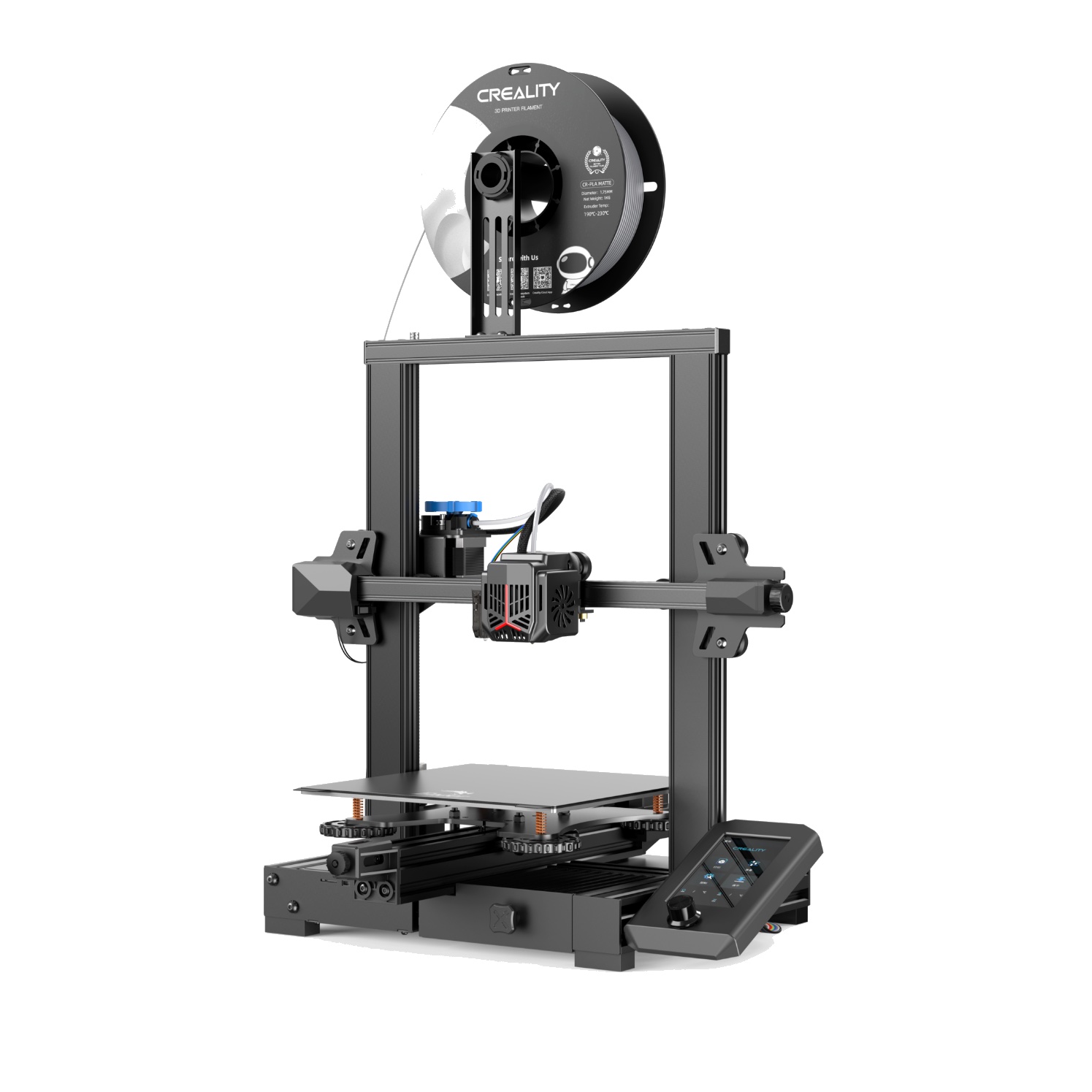Compare Ender 3 vs Ender 5 Plus vs Ender 3 V2 Neo
Comparison between the best 3D printers
Choose the best 3D printer at the best price. The cheapest 3D printers are here.
Buy a 3D printer here with 3D Fila.
 |
 |
 |
|
| Model | Ender 3[BUY Ender 3] |
Ender 5 Plus[BUY Ender 5 Plus] |
Ender 3 V2 Neo[BUY Ender 3 V2 Neo] |
| Printing Material | Filament | Filament | Filament |
| Estimated price | $210,00 | $599,00 | $310,00 |
| Fabricante | Creality 3D | Creality 3D | Creality 3D |
| Release Year | 2018 | 2019 | 2022 |
| Print Volume [mm] | 220x220x250 | 350x350x400 | 220x220x250 |
| Printer Size [mm] | 440x440x465 | 632x619x666 | 438x424x472 |
| Weight [kg] | 6,62 | 18,2 | 9,8 |
| Power Loss Recovery | NO | YES | YES |
| Enclosed printer | NO | NO | NO |
| Bed Leveling | Manual | Automatic | Automatic |
| Filament End Sensor | NO | YES | YES |
| Bed type | Heated | Heated | Heated |
| Power supply system | Bowden | Bowden | Bowden |
| Standard nozzle | 0,4 | 0,4 | 0,4 |
| Maximum Nozzle Temperature [°C] | 255 | 260 | 260 |
| Maximum Bed Temperature [°C] | 110 | 100 | 100 |
| Maximum printing speed [mm/s] | 180 | 180 | 80 |
| Filament holder | YES | YES | YES |
| Camera for supervision | NO | NO | NO |
| Recommended filaments | PLA, TPU, ABS, PETG | PLA, TPU, ABS, PETG | PLA, PETG |
| Recommended slicers | Cura, Simplify, Slic3r | Cura, Simplify, Slic3r | Cura, Simplify, Slic3r, IdeaMaker |
| Maximum Resolution [mm] | 0,1 | 0,1 | 0,1 |
| Processor | 8 bits | 32 bits | 4.2.2 mainboard |
| Display | Mono | Touchscreen TFT 4,3'' | Display touchscreen 4,3'' |
| Power Supply | 24V / 270W | 24V / 504W | |
| Connectivity | SD / USB | SD / USB | SD / USB |
| Operating systems | Windows, Mac, Linux | Windows, Mac, Linux | Windows, Mac, Linux |
| Date of registration in the system | 2021-04-13 | 2021-04-14 | 2022-12-09 |
| Release date | 2018 | 2019 | 2022 |
| Extra features | The Ender 3 V1 is a DIY assembly 3D printer, a sales leader since 2017, standing out for its cost-benefit. With a wide printing capacity, it has a CNC machined structure for precision and stability. It offers high-precision prints with low noise, thanks to its innovative V-profile and pulleys. It has a self-adhesive magnetic platform for easy removal of models and excellent adhesion. The Ender 3 heats up quickly, reaching 100°C in 5 minutes, ideal for agile prints. It includes protection against power failures, allowing you to resume printing after interruptions, saving time and material. | The Ender 5 Plus offers a large print volume (350x350x400 mm) and fast assembly. It includes a BLTouch sensor, but with range limitations. It stands out for its dimensional accuracy, although it requires adjustments to the slicer settings. Despite the noise, its integrated design saves space, and includes features such as a filament sensor and power resumption. Ideal for large projects, it requires refinement in the settings for high-quality prints. | The Ender 3 V2 Neo printer stands out for its automatic bed leveling with the CR Touch system, ensuring high-quality initial layers. It features an all-metal Bowden extruder for increased durability and improved filament handling. Its flexible, PC-coated magnetic build plate makes it easy to remove prints and is durable and easy to clean. It also includes a new user interface with model preview and an updated gantry design. The Ender 3 V2 Neo maintains the same build volume and temperatures as the previous version, supporting popular filaments such as PLA and ABS. It features a quiet 32-bit mainboard and additional features such as a filament sensor, print recovery, simple 3-step assembly, an integrated toolbox, and belt tensioners. |
| Support for multiple colors and materials (AMS and CFS) | NO | NO | NO |
Notes * |
|||
| Cost-benefit | 6 / 10 | 6 / 10 | 7 / 10 |
| Hardware | 0.5 / 10 | 2 / 10 | 2.8 / 10 |
| Screen | . | . | . |
| Print volume | 3 / 10 | 4 / 10 | 3 / 10 |
| Performance | 1 / 10 | 1 / 10 | 0 / 10 |
| [BUY Ender 3] | [BUY Ender 5 Plus] | [BUY Ender 3 V2 Neo] |
Conclusion |
| In comparing the three models of 3D printers from Creality—Ender 3, Ender 5 Plus, and Ender 3 V2 Neo—several factors emerge regarding their suitability for different users and projects. 1. **Ender 3**: This model is positioned as an entry-level printer, offering an excellent cost-benefit ratio. It features a compact design, manual bed leveling, and lacks advanced functions such as power loss recovery and filament sensors. While it has a smaller print volume, its simplicity and affordability make it ideal for hobbyists or those new to 3D printing who require solid performance without advanced features. 2. **Ender 5 Plus**: This printer appeals to users needing a larger printing capacity and enhanced dimensional accuracy. Equipped with automatic bed leveling and filament sensor features, it also includes power loss recovery capabilities, providing a more reliable printing experience for ambitious projects. However, its higher price point might deter budget-conscious users. This model requires more nuanced settings to achieve optimal print quality, making it more suitable for dedicated enthusiasts who are willing to invest time in calibration. 3. **Ender 3 V2 Neo**: The newer model combines many of the best features of the previous two. With automatic bed leveling, a durable all-metal Bowden extruder, and an updated user interface, it strikes a balance between usability and advanced features. The flexibility of its magnetic build plate and quiet operation also add to its desirability for users focused on quality and ease of use. Nevertheless, it comes at a moderate price compared to the other two. **Conclusion**: Choosing the best 3D printer among the Ender 3, Ender 5 Plus, and Ender 3 V2 Neo depends largely on the specific needs and budget of the user. The Ender 3 is best for beginners primarily interested in affordability, while the Ender 5 Plus is ideal for more demanding projects needing precision and larger print volumes. On the other hand, the Ender 3 V2 Neo represents a well-rounded option for users who seek modern features and ease of operation without stepping up to the price of the Ender 5 Plus. Therefore, the ideal choice will consider print volume, feature preferences, and budget constraints. |

